 |
As the earth blooms and the sky sings, the mere thought of Spring has inspired poets and composers through the ages to celebrate the resurgence of life with sweet, bouyant thoughts. But not Igor Stravinsky. His 1912 Le Sacre de Printemps (“The Rite of Spring”) the mere thought of Spring has inspired poets and composers through the ages to celebrate the resurgence of life with sweet, bouyant thoughts. But not Igor Stravinsky. His 1912 Le Sacre de Printemps (“The Rite of Spring”) was inspired by a vastly different muse. Surely one of the most important works in the annals of art, its impact still reverberates across all types of music. was inspired by a vastly different muse. Surely one of the most important works in the annals of art, its impact still reverberates across all types of music.
At the turn of the last century, serious music had reached the outer bounds of the tonal system and its future seemed in jeopardy. It took Stravinsky, in one bold and visionary gesture, to blast music into a wholly new realm of possibilities from which it would never return.
The 28-year old Stravinsky was the toast of Paris. 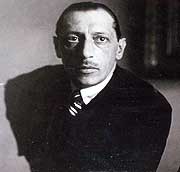 In 1910, he had launched his career with the hugely successful Firebird, a delightful ballet with a fanciful story and gorgeous music in the grand and familiar style of Tchaikovsky. For the next season he wrote Petrouchka which, while more modern, was anchored in memorable folk tunes and offered a charming tale of intrigue among established Commedia del'Arte characters. It was with such wonderful memories firmly in mind that society audiences anticipated yet another fabulous but essentially traditional entertainment. In 1910, he had launched his career with the hugely successful Firebird, a delightful ballet with a fanciful story and gorgeous music in the grand and familiar style of Tchaikovsky. For the next season he wrote Petrouchka which, while more modern, was anchored in memorable folk tunes and offered a charming tale of intrigue among established Commedia del'Arte characters. It was with such wonderful memories firmly in mind that society audiences anticipated yet another fabulous but essentially traditional entertainment.
Like its predecessors, The Rite was commissioned by Sergei Diaghilev for his Ballets Russes and was to be staged by Michel Fokine and choreographed by the legendary Vaslav Nijinski, the third triumphant crown of the most potent combination of music, art and dance that Europe had ever seen. But Stravinsky had other ideas. He would later say, “I was guided by no system; I wrote what I heard.” At the premiere, perhaps the most notorious of all time, it became immediately apparent that what he heard was without precedent.
The troupe's conductor, Pierre Monteux,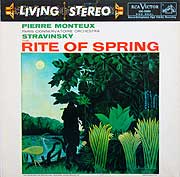 was introduced to the score when the composer played it for him on the piano. He recalled: “The very walls resounded as Stravinsky pounded away, occasionally stamping his feet and jumping up and down to accentuate the force of the music. Not that it needed such emphasis.” Monteux thought Stravinsky was “raving mad” and predicted the music would cause a scandal. He was wrong: it provoked a full-scale riot. was introduced to the score when the composer played it for him on the piano. He recalled: “The very walls resounded as Stravinsky pounded away, occasionally stamping his feet and jumping up and down to accentuate the force of the music. Not that it needed such emphasis.” Monteux thought Stravinsky was “raving mad” and predicted the music would cause a scandal. He was wrong: it provoked a full-scale riot.
The extreme difficulty of the music demanded an augmented orchestra   and the radical choreography required over a hundred rehearsals, which could not be accommodated as scheduled in the 1912 season. Instead, Ravel's Daphnis et Chloe was presented, fulfilling audience expectations with a mythic story, orthodox dancing and one of the most ravishing scores ever written. Anticipations for the delayed premiere of The Rite continued to rise. At last the fateful night of May 29, 1913 arrived. and the radical choreography required over a hundred rehearsals, which could not be accommodated as scheduled in the 1912 season. Instead, Ravel's Daphnis et Chloe was presented, fulfilling audience expectations with a mythic story, orthodox dancing and one of the most ravishing scores ever written. Anticipations for the delayed premiere of The Rite continued to rise. At last the fateful night of May 29, 1913 arrived.
The first two minutes apparently went well, with the audience enthralled by the haunting introduction. But then, the astringent brutality of the first scene broke through as,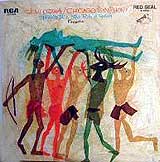 in Stravinsky's words: “the curtain rose on a group of knock-kneed and long-braided Lolitas jumping up and down.” The subject itself was scandalous: instead of the fanciful amorous stuff of fluffy ballet dreams, ugly pagans sacrifice a maiden to propitiate the gods of spring. The choreography, costumes and sets boldly dispensed with grace and beauty to emphasize awkward, primitive starkness. At first there were a few boos and catcalls, but then a storm broke as the outraged audience reacted by yelling and fighting. Diaghilev tried to quell the disturbance by switching the house lights on and off while Nijinski tried to sustain the performance as best he could by shouting out numbers and cues to the dancers, who couldn't hear the music, loud as it was, over the din. Stravinsky was furious and stormed out of the theater before police arrived to end the show. in Stravinsky's words: “the curtain rose on a group of knock-kneed and long-braided Lolitas jumping up and down.” The subject itself was scandalous: instead of the fanciful amorous stuff of fluffy ballet dreams, ugly pagans sacrifice a maiden to propitiate the gods of spring. The choreography, costumes and sets boldly dispensed with grace and beauty to emphasize awkward, primitive starkness. At first there were a few boos and catcalls, but then a storm broke as the outraged audience reacted by yelling and fighting. Diaghilev tried to quell the disturbance by switching the house lights on and off while Nijinski tried to sustain the performance as best he could by shouting out numbers and cues to the dancers, who couldn't hear the music, loud as it was, over the din. Stravinsky was furious and stormed out of the theater before police arrived to end the show.
But as happens so often in art, the scandals of the past generate the foundations of the future. Indeed, the very next year Monteux introduced the score in concert and its appeal began to take hold.  By 1929, the staid New York Times proclaimed the significance of The Rite “to the twentieth century as Beethoven's Ninth is to the nineteenth.” The arrival of The Rite in the pantheon of pop culture was clinched in 1940 when it was used in Walt Disney's Fantasia. At first Stravinsky resisted but ultimately accepted $5,000 for the film rights after being warned that if he didn't consent Disney simply would appropriate the score anyway due to copyright enforcement problems. The composer's reaction was to condemn the soundtrack performance (simplified and rearranged by Leopold Stokowski) as “execrable” and the associated depiction of a primordial world “an unresisting imbecility.” But Fantasia served its purpose – from that point on, The Rite has become one of the most popular of all modern scores, recognized and enjoyed by millions throughout the world. By 1929, the staid New York Times proclaimed the significance of The Rite “to the twentieth century as Beethoven's Ninth is to the nineteenth.” The arrival of The Rite in the pantheon of pop culture was clinched in 1940 when it was used in Walt Disney's Fantasia. At first Stravinsky resisted but ultimately accepted $5,000 for the film rights after being warned that if he didn't consent Disney simply would appropriate the score anyway due to copyright enforcement problems. The composer's reaction was to condemn the soundtrack performance (simplified and rearranged by Leopold Stokowski) as “execrable” and the associated depiction of a primordial world “an unresisting imbecility.” But Fantasia served its purpose – from that point on, The Rite has become one of the most popular of all modern scores, recognized and enjoyed by millions throughout the world.
Stravinsky's music is an absolutely brilliant component of the ballet, which opens in a wondrous evocation of the first promise of Spring and concludes in vicious human sacrifice. The score ranges from a plaintive folk tune to huge, pounding blows, from placid reverie to grating dissonance, and from bounding grace to irregular metric fragmentation. Stravinsky didn't set out to destroy tradition, but his jagged rhythms, wild harmonies and violent dynamics sidestepped the predicament of tonality and pushed music into a new dimension. In the process, he gave birth to so much of the music of our time.
Nowadays The Rite presents a vexing performance problem – how to restore the original impact. The score was intended to assault audiences with startling freshness, yet listeners now take its innovations for granted and thanks to Fantasia remember the work more as a 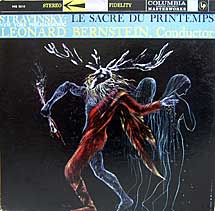 cartoon soundtrack for dancing dinosaurs than as the bold cornerstone of twentieth century music. In a stunning January 1958 record, Leonard Bernstein and the New York Philharmonic Orchestra restored The Rite to its rightful place in musical history. cartoon soundtrack for dancing dinosaurs than as the bold cornerstone of twentieth century music. In a stunning January 1958 record, Leonard Bernstein and the New York Philharmonic Orchestra restored The Rite to its rightful place in musical history.
Bernstein's solution to the problem of historical perspective was brilliant and yet, as so often with artistic triumphs, disarmingly simple. He was well aware that what shocked audiences in 1913 would seem pretty mild stuff two generations later. He couldn't expect audiences to turn back the clock, forget what they knew and participate in an aesthetic masquerade. Nor would he falsify the score by adding more “modern” elements. There was only one way to jolt contemporary listeners while preserving the integrity of Stravinsky's original conception: to generate a level of energy so intense as to restore the disparity between what the audience expected and what they had to feel. Bernstein's performance explodes with huge crackling sparks of rough, untamed excitement.
But all the frenzied podium gestures in the world would be unavailing without a corresponding contribution from the orchestra. The New York Philharmonic, in most critics' view, had become lazy and unkempt by the late 'fifties, sleepwalking through concerts without challenge. Recently appointed its permanent conductor, Bernstein's hyper baton turned their unruliness to superb advantage, inspiring them to overcome the boredom of professional routine and to convey an urgent sense of creating art afresh.
Fully reflecting its conductor's galvanic commitment, the Philharmonic's attacks are razor-sharp, its outbursts perfectly synchronized, its dynamics startlingly precise, and its virtuosity staggering, even in the most complex and difficult passages in which the score abounds. Most amazing of all, the players manage to suggest primordial snarls and shrieks that heighten the raw excitement of Stravinsky's conception.
The early stereo engineering provides startlingly vivid sound. A huge number of spot microphones must have been used, as we seem to crawl inside each of the instruments, and can actually feel the buzz of a vibrating reed, the grip of a rosined bow, the impact of a plucked string, the tense breath on a flute, the biting flatulence of the heavy brass. The very air reverberates with the sounds of primal nature, like an ancient forest pulsing with life. Above it all the percussion section is given extreme prominence, far louder than could be generated in any auditorium, with the tympani in particular tearing the sonic fabric with their harsh blows.
This is not the sort of realistic sound to which we have become accustomed nowadays, but Stravinsky's was hardly a natural conception. If the performance is a vibrant dream, its recording is a thrashing hallucination. The all-important rhythm, which pounds home the structure, and the exaggerated presence, 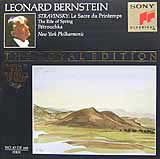 which underlines the radical harmonies, grab our attention, pull us inside a terrifyingly intense world and batter us with their overwhelming power. This is classical engineering at its most creative level – using the resources of the studio to enhance the composer's and performers' intentions. which underlines the radical harmonies, grab our attention, pull us inside a terrifyingly intense world and batter us with their overwhelming power. This is classical engineering at its most creative level – using the resources of the studio to enhance the composer's and performers' intentions.
This awesome performance is still available in the 1992 Bernstein Royal Edition (Sony SMK 47629), on a single mid-priced CD that sets the aesthetic perspective by including Stravinsky's previous ballet Petroushka. Accept no substitutes 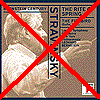 (including the more recent Sony Bernstein Century edition) – all other CDs of Bernstein Rites are of his diffuse 1972 and 1983 remakes with the London Symphony and Israel Philharmonic Orchestras. (including the more recent Sony Bernstein Century edition) – all other CDs of Bernstein Rites are of his diffuse 1972 and 1983 remakes with the London Symphony and Israel Philharmonic Orchestras.
It took 43 years and dozens of recordings for another to challenge the supercharged Bernstein/Philharmonic Rite (the sheer headstrong scrappy drive of Antal Dorati and the Minneapolis Symphony on Mercury 434 331 perhaps came the closest), but 2001 finally brought Valery Gergiev conducting the Kirov Orchestra (Philips 468 035) to recapture much of its thrill. 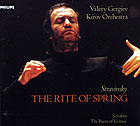 While his raw ferocity is less gripping than Bernstein's, Gergiev conjures tangible passion with startling precision, revelling in the score's intense color and arresting detail. He even trumps Bernstein's impeccable sense of drama by adding a startling twist to the final chord. The sound is more “natural” yet takes full advantage of the main superiority of digital fidelity over analog – capturing the bottom depth of orchestral sound, and especially the reverberation of the bass drum, with astounding power. And while at first the final sacrificial dance seems a bit slow, it grows chilling in its dispassionate relentlessness, as if to deplore from the vantage of our supposedly superior modern morality the routine boredom of death in less civilized times. While his raw ferocity is less gripping than Bernstein's, Gergiev conjures tangible passion with startling precision, revelling in the score's intense color and arresting detail. He even trumps Bernstein's impeccable sense of drama by adding a startling twist to the final chord. The sound is more “natural” yet takes full advantage of the main superiority of digital fidelity over analog – capturing the bottom depth of orchestral sound, and especially the reverberation of the bass drum, with astounding power. And while at first the final sacrificial dance seems a bit slow, it grows chilling in its dispassionate relentlessness, as if to deplore from the vantage of our supposedly superior modern morality the routine boredom of death in less civilized times.
If you seek an alternative Rite, there's seemingly no need for another less impressive 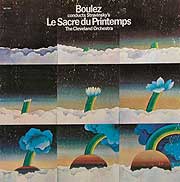 attempt at a dynamic approach, so you'd better go to the opposite extreme with either of the two chillingly precise performances with Pierre Boulez conducting the Cleveland Orchestra in 1968 (on Sony SMK 64109) or 1992 (on DG 435 769). Each leaves me cold, but is accompanied by a superb reading of Petroushka, which benefits enormously from Boulez's objective approach and places the full palette of orchestral color in glorious display. attempt at a dynamic approach, so you'd better go to the opposite extreme with either of the two chillingly precise performances with Pierre Boulez conducting the Cleveland Orchestra in 1968 (on Sony SMK 64109) or 1992 (on DG 435 769). Each leaves me cold, but is accompanied by a superb reading of Petroushka, which benefits enormously from Boulez's objective approach and places the full palette of orchestral color in glorious display.
Of incalculable historical value are the pioneering recordings by Monteux and Stravinsky, both cut in Paris in 1929. A word of warning, though –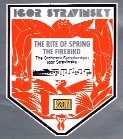 the Stravinsky records are not by the composer of the Rite. No, I haven't uncovered a fraud. It's indeed Stravinsky who wields the baton, but in the 16 years since the premiere he had undergone a vast change of artistic personality. No longer the wild firebrand who had scandalized musical society, he had converted to neoclassicism, and that's just the type of reading he leads here – dispassionate, manicured and reticent, with the final sacrificial dance downright labored. Even so, despite occasional awkward orchestral balances, Stravinsky does bring out the inner voices and the recording (on Pearl CD 9334) is fairly detailed with a good dynamic range. the Stravinsky records are not by the composer of the Rite. No, I haven't uncovered a fraud. It's indeed Stravinsky who wields the baton, but in the 16 years since the premiere he had undergone a vast change of artistic personality. No longer the wild firebrand who had scandalized musical society, he had converted to neoclassicism, and that's just the type of reading he leads here – dispassionate, manicured and reticent, with the final sacrificial dance downright labored. Even so, despite occasional awkward orchestral balances, Stravinsky does bring out the inner voices and the recording (on Pearl CD 9334) is fairly detailed with a good dynamic range. 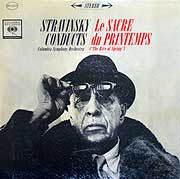 (Stravinsky's Columbia remakes with the New York Philharmonic (1940) and Columbia Symphony (1960) are somewhat peppier (and with faster finales) but still fall disappointingly flat in the climaxes and barely offset the bland impression of his first set.) (Stravinsky's Columbia remakes with the New York Philharmonic (1940) and Columbia Symphony (1960) are somewhat peppier (and with faster finales) but still fall disappointingly flat in the climaxes and barely offset the bland impression of his first set.)
Monteux's competing recording with the Orchestre Straram (on Pearl CD 9329) gives a far better reminiscence of the spirit of the premiere he had conducted. Unfortunately, the sound, even for its time, is poor – heavy compression and indistinct percussion ruin the dynamic excitement; the sixth side is soured by unstable speed; and four of the eight sides were thought to have been cut too loudly for the equipment of the time and so were issued only in lower volume dubbings which further compromise the already deficient fidelity. 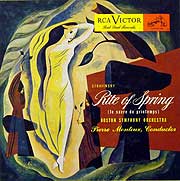 Even so, most of the instrumental detail is evident and despite some occasional sloppiness, the playing is good and the overall aura is of a rough, vigorous and committed reading. In any event, this was the very first recording of the Rite by a conductor with matchless credentials (Stravinsky, despite his unimpeachable genius as a composer, never really developed into a great conductor, even of his own work), and although Monteux undoubtedly mellowed somewhat in the intervening years, this is as close as we can come to the authentic feel of the infamous premiere. (Monteux's RCA remakes with the San Francisco Symphony (1945), the Boston Symphony (1951) and the Paris Conservatoire Orchestra (1958) are increasingly nondescript, devoid of energy or character.) Even so, most of the instrumental detail is evident and despite some occasional sloppiness, the playing is good and the overall aura is of a rough, vigorous and committed reading. In any event, this was the very first recording of the Rite by a conductor with matchless credentials (Stravinsky, despite his unimpeachable genius as a composer, never really developed into a great conductor, even of his own work), and although Monteux undoubtedly mellowed somewhat in the intervening years, this is as close as we can come to the authentic feel of the infamous premiere. (Monteux's RCA remakes with the San Francisco Symphony (1945), the Boston Symphony (1951) and the Paris Conservatoire Orchestra (1958) are increasingly nondescript, devoid of energy or character.)
1930 brought yet one more pioneering recording of the Rite – by Leopold Stokowski conducting the Philadelphia Orchestra (BMG 61394). 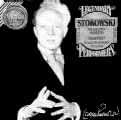 Aside from his notorious Fantasia soundtrack version (heavily reorchestrated and truncated) this would be Stokowski's only recording of a score he introduced to America. (A planned 1971 Phase Four taping was abandoned when he became ill.) It's a fascinating reading as Stokowski, true as always to his own form, recasts the work as utterly romantic – the accents are expressive, the sound is symphonic and the jagged rhythms are constantly smoothed out – yielding a sense of mainstream Wagnerian drama, as if to form a link with the very tradition Stravinsky railed against! The playing, as would be expected from the Philadelphians, is beautiful, the balances magnificently integrated, and the recording full and rich. The continuous flow among the eight original sides belies the apparent difficulty of the recording, which was spread over eight sessions during nearly a three-year period. Ironically, then, although this is the most conservative of the early Rite recordings, it turns out to be the most perverse and inauthentic. Aside from his notorious Fantasia soundtrack version (heavily reorchestrated and truncated) this would be Stokowski's only recording of a score he introduced to America. (A planned 1971 Phase Four taping was abandoned when he became ill.) It's a fascinating reading as Stokowski, true as always to his own form, recasts the work as utterly romantic – the accents are expressive, the sound is symphonic and the jagged rhythms are constantly smoothed out – yielding a sense of mainstream Wagnerian drama, as if to form a link with the very tradition Stravinsky railed against! The playing, as would be expected from the Philadelphians, is beautiful, the balances magnificently integrated, and the recording full and rich. The continuous flow among the eight original sides belies the apparent difficulty of the recording, which was spread over eight sessions during nearly a three-year period. Ironically, then, although this is the most conservative of the early Rite recordings, it turns out to be the most perverse and inauthentic.
One more recording of historical interest is the 1972 EMI/Angel LP by Michael Tilson Thomas and Ralph Grierson of Stravinsky's two-piano reduction with which he introduced the score to his friends. His partner on one such occasion in 1912 was none other than Claude Debussy, whose aesthetic could not have been further removed from Stravinsky's, but who proclaimed that it "haunted him like a beautiful nightmare." Although intended for rehearsals rather than public performance, the reduction unwittingly demonstrates the brilliance of Stravinsky's orchestration, which even two keyboards barely suggest.
And perhaps the most bizarre adaptation of the Rite is a rather literal arrangement by John Ringer for electric guitar, electric bass and percussion on a Scummy Job CD that can be heard either as insolent desecration (an opinion that would reflect the reaction of much of the original audience) or as a sincere salute to an early source of punk rock that would emerge to revolutionize pop music 60 years after the Rite had shaken classical music to its core.
But with all due respect for their significance, these recordings (and all but the recent Gergiev/Kirov that followed) pale beside that stunning 1958 achievement, which preserves a unique convergence of genius – Stravinsky's blazing conception, Bernstein's inspired interpretation, the Philharmonic's gripping execution and Columbia's brilliant engineering.

Copyright 2001 and 2002 by Peter Gutmann

|
